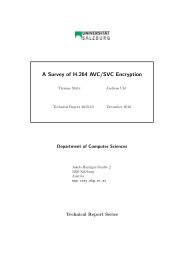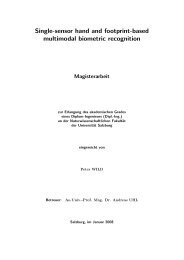Pit Pattern Classification in Colonoscopy using Wavelets - WaveLab
Pit Pattern Classification in Colonoscopy using Wavelets - WaveLab
Pit Pattern Classification in Colonoscopy using Wavelets - WaveLab
You also want an ePaper? Increase the reach of your titles
YUMPU automatically turns print PDFs into web optimized ePapers that Google loves.
4.3 Structure-based classification<br />
s<strong>in</strong>ce d Ti ,T i<br />
is just the distance of a quadtree of an image to itself, which must by def<strong>in</strong>ition<br />
of a metric always be 0. Therefore D is<br />
⎛<br />
⎞<br />
0 d T1 ,T 2<br />
. . . d T1 ,T n<br />
d T2 ,T 1<br />
0 . . . d T2 ,T n<br />
D = ⎜<br />
⎝<br />
.<br />
. . ..<br />
⎟ . ⎠<br />
d Tn,T1 d Tn,T2 . . . 0<br />
This matrix then conta<strong>in</strong>s the quadtree distances (similarities) between all possible pairs<br />
of images out of the tra<strong>in</strong><strong>in</strong>g image set.<br />
For each class c the matrix conta<strong>in</strong>s a submatrix D c which conta<strong>in</strong>s the distances between<br />
all images belong<strong>in</strong>g to class c. Therefore D can also be written as<br />
⎛<br />
⎞<br />
0 d T11 ,T 12<br />
. . . d T11 ,T 1n<br />
. . . d T11 ,T C1<br />
. . . d T11 ,T Cn<br />
d T12 ,T 11<br />
0 . . . d T12 ,T 1n<br />
. . . d T12 ,T C1<br />
. . . d T12 ,T Cn<br />
. . . .. . . . . .<br />
d<br />
D =<br />
T1n ,T 11<br />
d T1n ,T 12<br />
. . . 0 . . . d T1n ,T C1<br />
. . . d T1n ,T Cn<br />
. . . . . .. . . .<br />
d TC1 ,T<br />
⎜<br />
11<br />
d TC1 ,T 12<br />
. . . d TC1 ,T 1n<br />
. . . 0 . . . d TC1 ,T Cn<br />
⎝<br />
. ⎟<br />
. . . . . . .. . ⎠<br />
d TCn ,T 11<br />
d TCn ,T 12<br />
. . . d TCn ,T 1n<br />
. . . d TCn ,T C1<br />
. . . 0<br />
where d Tij ,T kl<br />
is the distance between the j-th image (quadtree) of class i and the l-th image<br />
(quadtree) of class k.<br />
Figure 4.5(a) shows an example distance matrix for the two-class case. This example<br />
shows a perfect distance matrix with very small <strong>in</strong>tra-class distances (black boxes) and very<br />
high <strong>in</strong>ter-class distances (white boxes). In reality however, a distance matrix is more likely<br />
to look like the one illustrated <strong>in</strong> figure 4.5(b), s<strong>in</strong>ce the trees for different images from a<br />
specific class hardly will be totally identical <strong>in</strong> real-world applications.<br />
As can been seen <strong>in</strong> figure 4.5 and follow<strong>in</strong>g from equation (4.40) the distance matrices are<br />
all symmetric.<br />
Hav<strong>in</strong>g calculated the matrix D the next task is to f<strong>in</strong>d the centroid of each class. A<br />
centroid of a class c <strong>in</strong> this context is the tra<strong>in</strong><strong>in</strong>g image out of I Tc which has the smallest<br />
average distance to all other images of class c. In other words, it is now necessary to f<strong>in</strong>d the<br />
image of class c to which all other images of class c have the smallest distance <strong>in</strong> respect to<br />
the chosen quadtree distance metric. After the centroids of all classes have been found the<br />
classification process can now take place.<br />
To classify an arbitrary image first of all the image is decomposed us<strong>in</strong>g the wavelet<br />
packets transform to get the respective decomposition tree. It is important to note that for<br />
classification the same cost function has to be used for prun<strong>in</strong>g the decomposition tree as<br />
was used dur<strong>in</strong>g the tra<strong>in</strong><strong>in</strong>g phase for all tra<strong>in</strong><strong>in</strong>g images. Then the distances of the result<strong>in</strong>g<br />
decomposition tree to the decomposition trees of the centroids of all possible classes are<br />
55








